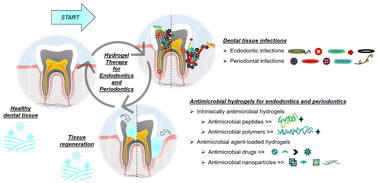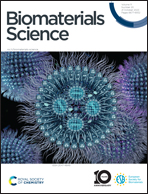Advances in antimicrobial hydrogels for dental tissue engineering: regenerative strategies for endodontics and periodontics
Abstract
Dental tissue infections have been affecting millions of patients globally leading to pain, severe tissue damage, or even tooth loss. Commercial sterilizers may not be adequate to prevent frequent dental infections. Antimicrobial hydrogels have been introduced as an effective therapeutic strategy for endodontics and periodontics since they have the capability of imitating the native extracellular matrix of soft tissues. Hydrogel networks are considered excellent drug delivery platforms due to their high-water retention capacity. In this regard, drugs or nanoparticles can be incorporated into the hydrogels to endow antimicrobial properties as well as to improve their regenerative potential, once biocompatibility criteria are met avoiding high dosages. Herein, novel antimicrobial hydrogel formulations were discussed for the first time in the scope of endodontics and periodontics. Such hydrogels seem outstanding candidates especially when designed not only as simple volume fillers but also as smart biomaterials with condition-specific adaptability within the dynamic microenvironment of the defect site. Multifunctional hydrogels play a pivotal role against infections, inflammation, oxidative stress, etc. along the way of dental regeneration. Modern techniques (e.g., 3D and 4D-printing) hold promise to develop the next generation of antimicrobial hydrogels together with their limitations such as infeasibility of implantation.

- This article is part of the themed collection: Injectable Hydrogels


 Please wait while we load your content...
Please wait while we load your content...